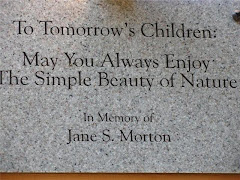 |
| Toledo's Butterfly Lady |
A man named Duke Wheeler opened the Butterfly House near Whitehouse, Ohio in 2001 as a showcase and sanctuary, and he consulted with Mrs. Stifel. She continued to train the staff and Mr. Wheeler said, “She had so much enthusiasm and knowledge. She was our guiding light for years.”
Mrs. Stifel was a career scientist who’d aspired to be a physician, but her interest in nature dated from childhood summers spent at her family’s Evans Lake cottage in southeast Michigan’s Irish Hills. In the 1970s, she read about a Cleveland Museum of Natural History field trip on how to tag Danaus plexippus — the monarch butterfly. She bought a membership that day and within weeks was teaching field-trip participants.It was only in the early 1970s that researchers from the north confirmed wintering sites in Mexico for the eastern North American monarch. A decade later, monarchs that had been tagged on Kelleys Island were found in central Texas and central Mexico, establishing that monarchs fly a Great Lakes-to-Mexico migratory pattern.
Mrs. Stifel was a dogged tagger of monarchs, roaming the Lake Erie shore with a butterfly net to catch and then affix a numbered bit of paper to a wing. In 1986, she attracted international attention with the recovery in Mexico of two monarchs tagged months earlier, and 1,500 miles away, in an eastern Lucas County clover field. Until then, no other monarch researcher was credited with more than one recovery, even though thousands were tagged every fall. In the next two years, her reputation soared as monarchs she tagged continued to be found elsewhere — in Mexico, but also Indiana and Kentucky. She raised as many as 600 monarchs a summer from eggs, tagged them, and released them.
“The more we know about nature, the more we should know about our way of living,” Mrs. Stifel told The Blade in 1996. She recruited others to her cause, teaching them about the monarch and how to tag. She campaigned against pesticides and the frequent mowing of ditch and roadside vegetation, which she said contributed to a decline in butterfly activity.
She also was a birder and a volunteer bald eagle nest watcher for the Ohio Division of Wildlife. She’d been a board and executive committee member of the Nature Conservancy’s Ohio chapter. Not surprisingly, she said in 1995, walking among the milkweed in search of monarch eggs, “I get a kick out of it too. School buses have gone by, and the children stick their head out the window and yell, ‘Hey, Butterfly Lady!’ ”
She was named naturalist of the year in 1995 by the Toledo Naturalists’ Association. In 2006, a gazebo to house the monarch project at Maumee Bay State Park was named in her honor.
Robert Morton, M.Ed., Ed.S. is dedicated to creating wildlife-friendly yards. Click HERE to make your yard wildlife-friendly by creating a Monarch Waystation. He'd enjoy hearing from you- press HERE to contact him.
